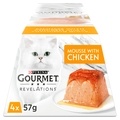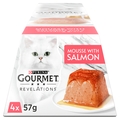Every cat owner knows that their feline companion will find ways to let them know what they want.
Many cats will use physical cues in order to get the attention of a human, such as nudging with the head or batting with a paw. However, some cats do not like being touched and will rely on using their voice. Even the least tactile cat will vocalise in order to get the attention of the owner.
Whilst cats make a range of sounds, the meow is the most used and the most versatile.
Being able to understand and decode the meaning of your cat's meows will help you understand what they are asking you to do.
Different Types of Meow And Their Meaning
Your cat generally only uses a meow to communicate with you.
In most circumstances, cats do not meow at each other and instead rely on different sounds and body language (all cat owners will know the sight of a cat with an arched back and hissing when meeting another cat they don't know!).
But over centuries of domestication, cats have learned to modulate and modify their meows to get different reactions from their human owners.
Let's look at the most common types of meow that you will hear from your cat.
The ‘Hello’ Meow
As a way to simply grab the attention of a human or say ‘hello’ your cat may give a slight chirrup or a very brief meow just to say that they are there.
The greeting meow is usually medium pitch and short in duration. It will also normally be at a mid-volume and only increase when a cat is really trying to make sure you've noticed its presence.
If your cat is keen on human company then the hello meow can often be accompanied by your cat rubbing up against you or circling and even nuzzling you with a softer repeated meow which lets you know how happy they are to be in your presence.
Sometimes you will hear a cat repeating a multiple series of the short meow when meeting a new person and it would seem to indicate that they like this new human.
The ‘Feed Me’ Meow
Perhaps the most understood reason a cat will try to get your attention with a meow is that they want to be fed.
Many cats meow to be fed outside of regular meal times simply because they are greedy, but all cats become accustomed to set meal times. When you deviate from these you will be assaulted with a battery of a longer, higher pitched more demanding series of meows.
It is often the relentlessness of these more pleading meows which cats have learned will get the results.
Of course, you will also hear this meow when you're eating something that looks particularly delicious and your cat wants a piece as well!
The ‘Do This’ Meow
You will sometimes mistake a pleading meow for a request for food when in fact your cat wants you to do something else.
Depending on how you have behaved with your cat as they’ve grown up with you the similar sounding request for your assistance could be any number of things, such as opening a door for them to go out, helping them look for a toy, or perhaps switching on a tap so they can get a drink.
Deciphering these meows can be tricky and you will only really be able to do so if you understand the kind of actions your cat has asked you to help them with in the past.
The ‘Help Me’ Meow
You will be able to tell when a meow means when your cat is in immediate need of help instead of just asking for you to do something.
Compared to the relatively even and slow meow when asking you to do something, when your cat is in need of urgent help the meow will change to faster, more frequent, and more high-pitched meows.
The meow will sound something like a screech or a cry so that you will know they need you or that they are frightened of something.
It should be clear from the pitch and force of the meow that they are not asking nicely but are, in fact, screaming for help.
In circumstances where a cat is severely injured, they may not be able to make this kind of meow, and instead, you will only hear a weak mewling which generally indicates a serious injury and you need to act to get them to a vet quickly.
The ‘Not Happy’ Meow
Conversely, if the pitch of the meow lowers and your cat makes a series of these low-pitched meows you're likely to be about to get a quick bite or a smack from a paw.
The lower pitch is an early warning sign that you're not doing what your cat wants or that what you're doing is annoying them.
It could be that something has made your cat scared, but it’s likely just that they’ve got fed up with you!
Other Vocalising
Of course, meowing is not the only sound that you'll be familiar with from your cat.
The next most common noise you'll hear from your cat is purring.
Cats purr almost exclusively when they are content and relaxed, but occasionally a cat will purr as a means of coping with anxiety or stress. In that situation, the purr seems to be an internal method of anxiety control almost like meditation in humans.
Chirruping, as we said at the start of this article, can be a form of saying hello, but it can also show interest. Cats often chirrup when they see potential prey or something that excites them.
Of course, the other sound you will hear from a cat is a low growl possibly accompanied by hissing which, as we said, is a clear display that your cat is feeling angry or threatened.
How Much Meowing is Too Much?
Don’t be concerned if you think that your cat meows more than others.
There is no normal amount of meowing and some cats are just more chatty than others.
Your cat may be meowing more at a certain time because they aren't getting enough attention and is simply trying to get you to pet or play with them more, or it may be trying to get you to take a specific action.
The only time to worry about your cat meowing more than normal is if you are able to discern (from this list of types of meow) whether your cat may need help with an injury or some other health issue.
Help Meow-t!
This list of types of meows should help you interpret what your cat is trying to communicate when they meow.
Take the time to think about why your cat is vocalising at you and you will build a deeper bond so that you can tell how your cat would like you to act (not just when they want to be fed!)
About the Author
Sam Jones is a feline expert focusing on cat behaviour, cat health, and cat care. She has lived with cats her entire life and has been writing about cats for as long as she can remember. She is currently a senior contributing editor at We Love Cats and Kittens.
Written by: Sam Jones (Guest Author) (Guest Author)









